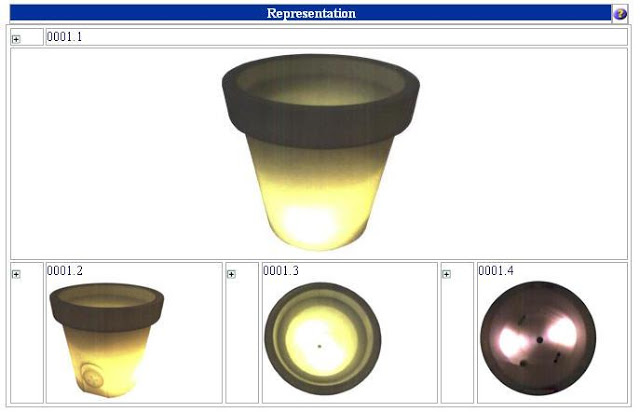The issue concerned arose in Case 200.060.916/01 Slewe Beheer & Bloom Holland v The Groove Garden, judgment of 13 December 2011, concerning illuminated flower pots (yes, really - they take their flowers pretty seriously in the Netherlands).
If your Dutch is good, there is commentary here and here. I believe (but check with the Dutch sources if you are interested) that the outcome was good for the plaintiff in that copyright infringement was found. This comment just concerns the Registered Community Design.
The plaintiff's pot, known as the BLOOM, is, it would appear, not dissimilar to the defendant's.
A straightforward design infringement, as with the copyright? Apparently not.
The RCD, number 000122189-0001(reproduced below), "merely discloses a pot made of transparent material containing one or two sources of light. There is no evidence to suggest that the illumination is integrated and closed in between a double bottom." These features were present in the Bloom product, and indeed may have been invented by the plaintiff, but since they were not explicitly visible they were not taken into account in assessing the design.
Apparently, the Court would have been satisfied with some verbal description of these features, for they commented that "Pursuant to Article 36(2) of the Regulation, the application shall contain an indication of the products in which the design is intended to be incorporated or to which it is intended to be applied. Although paragraph 3 allows the option for the application to contain a description explaining the representation, Slewe restricted itself to the following "Indication of the product": "Pots (household), Pails, Plant pots, Flower boxes (outdoor), Lamps, Cribs for animal fodder". A description as a explaining the representation is absent, and the indication of the product is inaccurate or incomplete in that it fails to state that the product is a plant pot which can simultaneously act as a lamp. As a consequence, the Court of Appeal finds that it is to be assumed that the design merely discloses a pot made of a transparent material and containing one or more light sources, which is what the informed user must base his comparison of this pot and the VAS-ONE and the GG pot on (not a pot with integrated illumination contained in a double bottom)."

Then comes the unkind part: since the infringement, which they had found to be copied from the plaintiff, did "feature an integrated closed white bottom containing integrated illumination, with the light source itself not being immediately visible (only its light shining through the double bottom) in (the visible inside of) that pot. In that pot, there is a white, closed, smooth (double) bottom. This entails that the design rights have not been infringed"
None of that is the contentious point, however. That arises from a matter seemingly not in issue: the relevant date for assessing prior art, discussed in para 26 of the decision: "
Pursuant to Article 7(2)(b) of the Regulation, the relevant date for assessing the novelty and individual character is the date 12 months before the date of filing of the application ...". They repeated the erroneous date at para 36.
Article 7(2)(b) CDR is, of course, the grace period provision. As (*ahem*) I noted back in 2002 at para 1-065 of my book, "
The grace period exempts disclosures from invalidating; it does not use them to establish a starting date for protection (a priority date or a date of conception)." It appears that the Court have fallen into the error I warned against there. Or have I missed something?


 Sharing on Social Media? Use the link below...
Sharing on Social Media? Use the link below...
